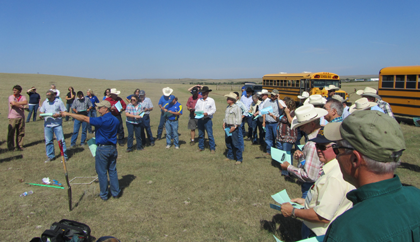Thanks to the foresight of SDSU researchers, South Dakota landowners making management decisions for their grazing lands and livestock can benefit from more than 70 years of data gathered at the Cottonwood Range and Livestock Field Station, operated by SDSU's Agricultural Experiment Station.
Located near Philip, S.D., the Field Station was established in 1907 - with a facility consisting of one section of land focused mostly on crop and cattle research. The research shifted to range livestock production when 2,000 acres were added in 1940. Since 1942, researchers have measured livestock production and vegetation change across a wide range of climate conditions - and much of that work continues today.
The long-term grazing data generated at the research station over the decades gives scientists - and ranchers - insight that a simple two- or three-year study cannot, explains Pat Johnson, a range scientist at the SDSU West River Ag Center in Rapid City. She has been conducting research at the Cottonwood Field Station since 1987.
Understanding Drought
Long-term studies show how changes in precipitation, such as drought, can affect plant community composition and production for years. "It's not as simple as saying drought will produce this kind of vegetation and livestock production," Johnson says. "Drought can have effects not only during the drought years, but for several years following the drought."
Utilizing long-term data collected at the Cottonwood Field Station, Ag Experiment Station researcher Alexander "Sandy" Smart recently developed a tool to predict forage production based on factors such as precipitation. This helps ranch managers anticipate in early to mid-summer how many cattle their pastures may support and for how long. "That's very valuable for people making drought management decisions," Johnson explains.
Interestingly, since 1907 the National Weather Service has recorded area weather at the Cottonwood Field Station - making it one of the oldest continuous weather stations in the state. Maximum and minimum temperatures are recorded daily, along with precipitation and evaporation data.
Studying Stocking Rates
Since the 1950s, researchers have explored how stocking rate affects the mixture of native prairie grasses. These studies looked at how to set stocking rates on pastures that were historically overgrazed with the goal of "getting back good native plant communities," Johnson says.
A heavy, long-term stocking rate often turns rangeland with midgrasses, such as western wheatgrass and green needlegrass, into a plant community dominated by shortgrasses like buffalograss, blue grama and sedges, according to Johnson. Lighter stocking rates are needed to maintain the midgrasses in the plant community.
For many years, management professionals recommended that ranchers utilize light to moderate stocking rates. In the Northern Great Plains, that will result in a mixture of native grasses dominated by midgrasses, Johnson notes. However, because of research continuing to be conducted by SDSU at Cottonwood, recommendations have changed somewhat in the past 10-15 years.
Johnson explains that stocking rates should be determined based on the ranchers' management goals. For example, more plant biomass is produced with midgrasses compared to shortgrass-dominated pastures. With a relatively light stocking rate on midgrass dominated pastures, individual animal weight gains are maximized.
Shortgrass-dominated pastures, with a heavier stocking rate, typically produce lower individual animal weight gains, explains Johnson. However, the heavy stocking rate usually yields a greater total gain per acre because there are more animals per acre per month.
Many ranchers in western South Dakota maintain shortgrass-dominated pastures, which tolerate a higher stocking rate and therefore produce a higher total cattle weight gain per acre of pasture.
"On a per animal basis, the cattle don't gain as well, but there are more of them," explains Johnson. For many ranchers in this region, there has been an economic benefit from maintaining the heavier stocking rates on shortgrass pastures.
However, there is a limit to how heavily native pastures can be grazed, Johnson cautions. If the stocking rate is too heavy, the shortgrasses will disappear, weeds will increase and bare ground will be exposed - and livestock production on both a per-animal and per-acre basis will be reduced.
It's a balancing act, she concludes - one that SDSU range scientists will continue to study and provide input to ranchers.
Watching Watersheds, Too
As part of their rangeland research at the Cottonwood Range and Livestock Field Station, SDSU researchers have monitored watersheds too. In comparing shortgrass and midgrass plant communities they have studied how much water and sediment come off these communities.
SDSU's Johnson explains that shortgrass pastures absorb much less rainfall into the soil, so they shed much more water than midgrass pastures. However, research conducted by SDSU and the U.S. Department of Agriculture at the Cottonwood Field Station showed that when enough water is applied to both types of plant communities to create runoff on the midgrass-dominated pastures, more runoff occurs on the shortgrass pastures - but both produce about the same amount of sediment.
This runoff scenario is important because all that water is moving off the rangeland, instead of being used for plant production, Johnson points out, and then drains into streams, where it scours the banks and adds silt to rivers and lakes.
The sediment-loss results of the watershed studies at Cottonwood are, however, not at all typical of other types of rangelands in the western United States, Johnson explains. Sediment losses from most rangeland in the western United States are typically greater for plant communities associated with heavier stocking rates.
"Our plant communities are really good at hanging on to the soil," Johnson says, "and our pastures don't fit the patterns that we see elsewhere." And that makes the studies conducted at Cottonwood Field Station even more valuable to South Dakota ranchers.
This information was originally published in the SDSU Agricultural Experiment Station 2013 Annual Report.

SDSU range science professor and researcher Sandy Smart (pointing) shared findings from grazing management studies being conducted at the Cottonwood Range and Livestock Field Station with producers attending an open house at the facility in September 2013.





